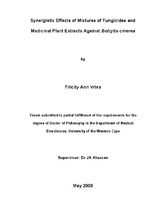| dc.description.abstract | We hypothesize that South African medicinal plants contain compounds that can act in synergism with synthetic antifungal compounds. Four fungicides - Sporekill™, Rovral™, Terminator™ and Teldor™ at doses 0.1, 0.2, 0.4 and 0.8 mL L-1 and plant species Galenia africana, Elytropappus rhinocerotis and Tulbaghia violacea were tested aloneand in different combinations for their potency (efficacy) on radial growth inhibition of Botrytis cinerea strains on potato dextrose plates. Four doses of plant extract for each of the respective plant species were used. A total of 48 combinations were tested for each strain. Mixtures of plant extracts were far more effective in controlling strains compared to the individual components alone, representing significant levels of in vitro synergistic interactions. Combinations of these components represent an attractive future prospect for the development of new management strategies for controlling B. cinerea. Since the in vitro tests of these mixtures showed inhibitory activity, the mixtures were tested for activity in assays on Granny Smith apples. In vitro tests can be used to screen mixtures to obtain information on their inhibitory activity on a pathogen, however, the environmental conditions of the fruit and the ability of the pathogen to grow into the fruit cannot be simulated in vivo. A series of two-fold doses of medicinal plant extracts were combined with fungicides to conduct decay inhibition studies. The incidence of gray mold was significantly reduced by mixtures of plant extracts and fungicides. Under conditions similar to those in commercial storage, a drench treatment with G. africana and Rovral™ significantly (p=0.05) inhibit gray mold on the apples and was more effective than the plant extract and fungicide alone. The treatments exerted synergistic effects and were markedly better than the components applied alone. The wound colonization assay was used for optimal decay control. In a drench, much higher volumes of the treatments are used to ensure that the components of the suspension are deposited evenly over the entire fruit surface. Drenching of fruit to apply other chemicals is an established practise in the pome (fleshy) fruit industry, and simplifies the commercial application of the mixtures, as no additional infrastructure at commercial packing houses will be required. This approach not only makes it possible to reduce fungicide concentrations while maintaining adequate decay control, but also ensures a reduction of the chemical residue on the fruit. | en_US |

